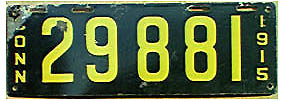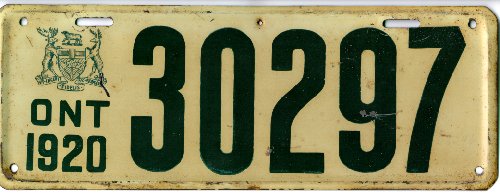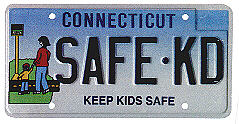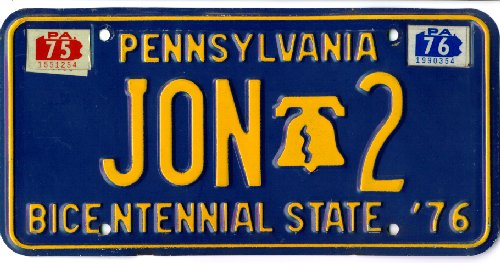Introduction to License Plate Collecting
by Jonathan Upton (#7135)
Getting Started
License plate collecting can be a challenging and complex hobby. There's much more to it than simply having a box of old tags in the attic, or nailing loot from the local junkyard to the walls of a garage or barn—but these are good starts.
License plates are used all over the world, and they've been around since the turn of the century. In fact, some of the oldest plates in the world are from before 1900. There's a lot about license plates which makes them inherently collectible—their color, origin, age, shape, condition, history... and the list goes on. There are so many different varieties of license plates in existence that collecting them all would be an impossible task. Most collectors set goals of collecting plates which are somehow close to their hearts. Perhaps that would be a collection of plates from a single year, or maybe from a certain state or town. Some people even collect plates from foreign countries which no longer exist.
The real question to a new collector would probably involve asking where to look for license plates, and that's not an easy question. Sometimes you find plates, and other times they find you. Stopping by a local junkyard or a rural dump is always a good place to start. Some collectors regularly visit auto scapyards to gather new acquisitions. Some of the luckier collectors may be able to get used plates directly from their local DMV office—but plates are tightly regulated in some places, so don't hold your breath. License plates have also shown up in antique shops, flea markets, outdoor automotive markets, and cluttered second-hand stores. One of the best things to do is to look up the address of a local plate collector—they're usually quite eager to "talk plates" with people, and they may just make you a few deals.
Over the last few years, the hobby has been exploding. The internet is now a valuable resource for many collectors. Deals and trades are made daily over e-mail, and many collectors even host their own plate-related websites!
Passenger Plates


Passenger plates are those issued to private cars. The earliest plates had a porcelain finish, much like your stove or bathtub. In the early years, some of these plates had no dates, but can usually be identified, thanks to records and research.
Massachusetts issued the first license plate in the US in 1903. Before that, some states like NY issued a number and asked motorists to make up their own license plate- but they did not manufacture and issue a plate.
Some early plates were made of flat metal and simply had their numbers and designs stamped in paint on the face of the plate. These plates are known by collectors as "flats".
In the 1920's, most states began to issue embossed metal plates. These were made of tin, steel or aluminum, with the numbers stamped into the plates by dies. This method of producing license plates has remained basically the same right up to the current day.
In the 1970's and 80's, some states experimented with reflective sheeting on their license plates. While many early examples of this white sheeting turned yellow, today this is the most widespread method of making USA license plates. Many states have introduced very attractive and colorful designs using this technology.
Non-Passenger Plates




Another classification of license plates is non-passenger plates. These are generally those plates which are not general-issue to private cars. Included in this are Truck, Trailer, Dealer, and Temporary plates.
Most states issue numerous classifications of non-passenger plates. Many of these types, such as truck and trailer, are very easy to come by. Other types, such as Connecticut's 'Exp. Test' and California's 'Remanufacturer' plates are not so easy to get.
Special Passenger and Non-Passenger Plates
Included in this are plates which are generally not issued to everyday people. These plates include Police, government, and political plates. These can be fairly easy to obtain for some states, although many are much more difficult to find.
Special-Issue Plates
These plates are extra-cost plates issued by most states. Some benefit environmental programs, some benefit various organizations, and some benefit other special causes.
Vanity Plates
Known also as personalized or prestige plates, these are the customized plates you can obtain for your car with your personal message on it. These are fairly easy to add to your collection, and chances are that eventually you will even find one with your name or initials on it.
Common Terms
- Base
- used to describe a plate which may be renewed by stickers for multiple years.
- Colors
- generally the colors of the plate are described by 'foreground color' on 'background color'. E.g. if a plate has black numbers on a white background, it would be referred to as 'black on white'.
- Decal or sticker
- small sticker applied to plates to indicate the month and/or year or expiration.
- Graphic plates
- those with reflective sheeting screened with pictures or text used as the background of the plate.
- M/C
- an abbreviation of the word "motorcycle".
- Retouch
- a small paint job to cover up a small area of missing paint.
- Seals
- older plates can have metal badges attached to them; e.g., early Pennsylvania plates. Also refers to stamps and/or identifying designs or logos on foreign plates, typically from Europe.
- Tabs
- these are small pieces of metal attached to license plates to indicate the year of expiration. Most states stopped using metal tabs in the early 60's, in favor of cheaper and easier to apply decals.
What to Collect?
An important thing to do when starting a collection is to decide what you're going to concentrate your collection on. Some collectors concentrate on their home state, others on certain years or types.
- If you are Native American, try collecting Native American plates!
- If you drive a truck, how about truck, pro-rate and apportioned plates?
- If you ride a m/c, then how about m/c plates.
- A car buff? Try Antique Auto plates.
- An amateur radio operator? Wouldn't it be fun to get a HAM plate from every state and province.
- How about collecting plates from every place you have visited?
License Plate Runs
Many collectors aim to complete at least one 'run' in their collection. There are three major types of runs- state runs, year runs and type runs.
- A state run is a collection consisting of one plate from each year from a particular state.
- A year run is having a plate from each state and/or province from a particular year. Many collectors will try to complete a run of plates from the year they were born, others will concentrate on other years, such as the 1976, the year of the US bicentennial.
- Type runs are also common. Some collectors will try to get a dealer or apportioned plate from every state.
- Type sets are of interest to specialists. This is a run of all types of plate for an entire base or year for a given state.
These are no rules as to which types you can use to collect a type run. Choose one that's of particular interest to you and you will enjoy it even more.
Finding License Plates
These are many places to find license plates. Most states will sell you a 'sample' plate for a small fee. These are plates which are created for display purposes only, and cannot be used on a motor vehicle.
Other places to find plates are ALPCA regional conventions, flea markets, ads in license plate publications such as the ALPCA newsletter, and antique shops.
Plates are most plentiful at conventions and in newsletter ads, and are typically offered at a fair price.
Flea markets can be excellent places to find inexpensive plates, but beware of those who believe that their plates are gold plated. There are many bargains to be found at flea markets, but there are also many highly-inflated prices. Shop smart, and don't pay more than you believe a plate is worth.
Antique shops can be excellent sources of plates, especially older ones. Don't expect to find spectacular bargains, but many shops are willing to negotiate prices. Generally you can buy plates here for book value, if not slightly less.
Stopping by a local junkyard or a rural dump is always a good place to start. Some collectors regularly visit auto scrapyards to gather new acquisitions. Some of the luckier collectors may be able to get used plates directly from their local DMV office—but plates are tightly regulated in some places, so don't hold your breath.
One of the best things to do is to look up the address of a local plate collector—they're usually quite eager to talk plates with people, and they may just make you a few deals.